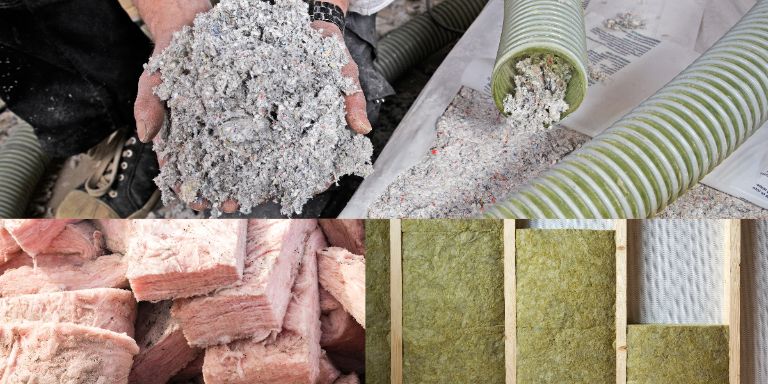
With the unpredictable Michigan weather, ensuring your home is insulated adequately is crucial. Blown-in insulation is a favored choice among homeowners due to its efficient installation process and its ability to fill in tight spaces effectively. As your trusted blown-in attic insulation experts, Storm Master Exteriors offers insights into the three most popular materials: Cellulose, Fiberglass, and Rockwool. Let's dive in!
Cellulose is often praised for being an eco-friendly option. It’s primarily made from recycled newspaper treated with fire retardants.
Environmentally Friendly: It utilizes up to 85% recycled content.
Tight Seal: Its dense composition is effective at filling nooks and crannies, making it ideal for older homes with irregular framing.
Cost-Effective: Often, it is less expensive than other blown-in insulation types.
Settling Over Time: It may settle over the years, reducing its initial R-value.
Moisture Concerns: If exposed to moisture, it can lose its insulating properties and be a potential mold risk.
Fiberglass, made from fine strands of glass woven into a mat, is a well-known insulation type.
Non-Flammable: Its materials are naturally fire-resistant.
Durable: Resists mold and pests, and does not settle or deteriorate over time.
Effective Thermal Barrier: Offers a dependable R-value, especially if installed correctly.
Protection Needed During Installation: The tiny glass shards can irritate the skin and lungs. Thus, proper gear during installation is essential.
Slightly Higher Cost: Generally, it is more expensive than cellulose.
Derived from basalt rock and slag, Rockwool (or mineral wool) provides both insulation and soundproofing.
Fire Resistance: Can withstand temperatures up to 2150°F, making it one of the most fire-resistant insulations available.
Soundproofing Qualities: Effective in reducing noise transmission due to its dense composition.
Moisture Resistant: It doesn’t retain water, thus reducing the risk of mold growth.
Higher Cost: It is generally more expensive than both cellulose and fiberglass.
Weight: Being denser, it might not be ideal for all attic types.
Selecting the best insulation material for your home often depends on your specific needs.
Budget: If you're working within a tight budget, cellulose might be your best bet. However, if you're prepared to invest a bit more for added benefits, fiberglass or Rockwool could be worth the consideration.
Home Age & Structure: For older homes with irregular spaces, cellulose offers an excellent fit. However, newer constructions might benefit more from fiberglass or Rockwool.
Fire Safety Concerns: If fire resistance is a top priority, Rockwool stands out.
Environmental Considerations: Those keen on eco-friendly options will appreciate the recycled content in cellulose.
Before making a decision, consult with blown-in attic insulation experts to assess your home and provide tailored recommendations.
In the world of home insulation, blown-in solutions are quickly becoming the gold standard for homeowners, and for a good reason. Here are some compelling arguments for choosing blown-in insulation for your attic:
Seamless Coverage: Traditional batt insulation can leave gaps and spaces. Blown-in insulation, on the other hand, provides comprehensive coverage, filling in every nook, cranny, and irregular space, ensuring maximum efficiency.
Quick and Clean Installation: Our team at Storm Master Exteriors has honed the installation process to be quick and minimally invasive. There's no tearing down walls or lengthy disruptions; our experts can insulate your attic efficiently, often in less than a day.
Energy Savings: Blown-in insulation boasts superior thermal properties, helping you save on heating and cooling costs. Given Michigan's challenging weather, the insulation will prove to be a cost-effective investment as it reduces energy consumption and your monthly bills.
Longevity: Blown-in insulation materials, whether it's cellulose, fiberglass, or Rockwool, are durable and long-lasting. When installed correctly, they can serve your home for decades, maintaining their insulating properties over time.
Environmentally Friendly: Particularly with cellulose, the high recycled content means you're making an eco-conscious choice, reducing the demand for virgin materials and decreasing the carbon footprint associated with your insulation.
Home Value Boost: Prospective homebuyers appreciate the benefits of a well-insulated home. By opting for blown-in insulation, you're not only ensuring comfort and energy efficiency but also potentially increasing your home's resale value.
While each of these insulation materials comes with its set of advantages and disadvantages, they all provide effective solutions to the primary goal: keeping your home comfortable and energy-efficient. With a clearer understanding of their unique characteristics, you can make an informed decision that best aligns with your home's needs and your personal preferences.
For those in the Freeland area and beyond, Storm Master Exteriors is your trusted partner for top-quality insulation services. We understand the nuances of Michigan's climate and are well-equipped to provide the best insulation solutions tailored to your needs. Invest in blown-in insulation today and enjoy a comfortable, energy-efficient home for years to come.
